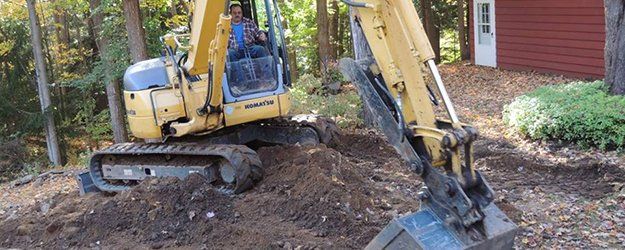Unveiling the Art of Excavation: Pro Tips for Safe and Efficient Excavating
In the world of excavation, the mastery of safe and efficient digging is an art type that needs understanding, adherence, and accuracy to well-known techniques. As soil is transformed and planet is moved, the details of excavation expose themselves, requiring an eager understanding of equipment, soil composition, safety and security methods, and environmental considerations. The proficiency required to browse these elements properly can mean the distinction between an effective excavation job and a possible calamity. By untangling the layers of this complex process, a world of methods and insights waits for those looking for to raise their excavation skills to new elevations.
Significance of Proper Devices
To guarantee the safety and security and efficiency of any type of excavation task, using the proper equipment is paramount. Excavation projects vary in scope and complexity, ranging from little domestic landscaping tasks to large building endeavors.
Excavators are basic pieces of equipment in any digging operation. These flexible makers can be found in numerous dimensions to fit different task needs. Mini excavators are suitable for smaller jobs, while larger excavators tackle much more substantial tasks efficiently. Backhoes are an additional crucial equipment kind, incorporating the features of a loader and an excavator in one device. They are valuable for jobs needing convenience and maneuverability.
Aside from excavators, other important devices consists of dump plates, bulldozers, and vehicles. Dump vehicles are essential for removing and transferring excavated products, while trenchers are made use of for excavating deep and narrow trenches. Bulldozers master jobs that need pressing big quantities of dirt or particles. By buying the suitable tools, excavation projects can be finished securely, in a timely manner, and with accuracy.
Comprehending Dirt Make-up
An extensive understanding of soil make-up is essential for performing excavation projects with accuracy and safety and security. Understanding the various types of dirt is crucial as it straight influences excavation methods, equipment option, and overall project performance. Soil structure usually consists of 4 main parts: sand, silt, clay, and natural matter. Each component has special residential or commercial properties that affect just how dirt reacts to excavation processes.
Sand particles are the biggest and give good water drainage yet offer little communication. Silt particles are smaller than sand yet larger than clay, offering modest water drainage and cohesion. Clay particles are the smallest and provide high cohesion but poor drainage. Raw material, such as rotting plant product, influences dirt fertility and stability.
Prior to starting excavation, carrying out dirt tests to identify its make-up and qualities is essential. This information aids in selecting the suitable equipment, carrying out precaution, and developing excavation techniques customized to the details soil conditions - excavating ohio. By recognizing soil structure, excavation professionals can improve project end results while ensuring safety and security and adherence to best practices
Precaution and Protocols
Understanding soil structure is the cornerstone whereupon safety actions and methods for excavation jobs are developed, making sure the health of workers and the success of the endeavor. There are a number of crucial steps that have to be implemented to mitigate threats and avoid accidents. when it comes to safety during excavation.
Firstly, prior to any digging starts, a detailed assessment of the site need to be carried out to determine any potential threats such as underground utilities, unstable dirt conditions, or close-by structures that might posture a risk. It is important to have a competent person oversee the excavation procedure to guarantee that all safety and security methods are adhered to strictly.
In addition, all workers entailed in the excavation has to be correctly educated in secure digging techniques and the correct procedure of devices. By sticking to these safety and security measures and procedures, excavation tasks can be completed efficiently and without occurrence.
Effective Excavation Preparation
When embarking on an excavation task, meticulous planning is vital to guarantee efficiency, security, and successful results. Reliable excavation planning involves several vital actions that are crucial for the smooth execution of the job. The very first step is to perform a detailed site analysis to recognize any kind of possible dangers, such as underground utilities or unpredictable soil problems. This info is essential for developing a detailed excavation strategy that includes precaution and risk mitigation methods.
As soon as the site analysis is full, the next action is to produce a clear timeline and routine for the excavation activities. This consists of figuring out the series of jobs, tools requirements, and workforce allocation. Proper scheduling aids avoid delays and makes certain that the project remains on track.

Furthermore, communication among all group participants is vital during the planning phase. Clear instructions, normal updates, and reliable sychronisation are vital for a successful excavation project. By investing time and initiative in careful planning, excavation teams can significantly boost productivity, reduce threats, and attain successful click here to read results.

Handling Ecological Factors To Consider
With raising focus on environmental sustainability in construction practices, managing ecological considerations has actually ended up being a vital aspect of excavation tasks. Excavation tasks have the prospective to influence the surrounding setting through dirt disintegration, sediment runoff, environment disturbance, and contamination of water resources. To minimize these risks, it is vital to carry out ideal techniques that focus on ecological security.

Additionally, proper waste administration is critical to avoid dirt and water contamination. Carrying out treatments for the disposal of dangerous materials, recycling of waste products, and decreasing using damaging chemicals can substantially reduce the ecological impact of excavation projects. By incorporating these practices into excavation preparation and execution, building and construction business can make sure that their projects are not just risk-free and productive however likewise eco liable.
Verdict
Finally, grasping the art of excavation calls for a complete understanding of appropriate devices, soil composition, precaution, and efficient planning. By following these guidelines and considering ecological factors, excavations can be conducted securely and successfully. It is essential to More about the author focus on security and efficiency in every digging job to guarantee effective end results.
As dirt is transformed and earth is moved, the details of excavation expose themselves, requiring a keen understanding of devices, soil make-up, safety and security protocols, and ecological factors to consider.To ensure the safety and efficiency of any kind of excavation project, making use of the appropriate tools is vital.A comprehensive grasp of dirt structure is essential for performing excavation tasks with accuracy and safety and security. Recognizing the various types of soil is vital as it straight impacts excavation approaches, tools selection, and general job performance. review By comprehending soil structure, excavation experts can enhance task outcomes while guaranteeing safety and adherence to ideal practices.